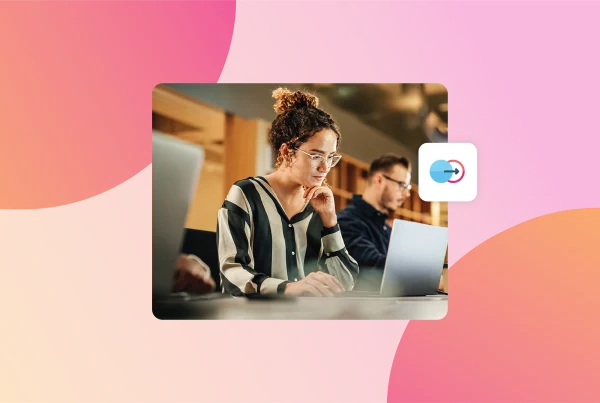As people strive for personal and professional growth, they often encounter barriers that can impede their learning success.
These barriers are problematic as they can hinder progress, diminish motivation, and restrict the acquisition of critical new knowledge and skills. 😬
In order to combat this, organisations must help their employees at any stage of their careers to identify and understand these issues to help solve them and unlock the untapped potential of continuous learning. 🔐
By acknowledging these challenges, employees can develop effective strategies to navigate them and embark on a transformative lifelong learning and personal development journey. 🗺️
Here we will be taking a deep dive into the 7 most notable barriers that can obstruct learning success. 🚫
Moreover, we will provide valuable insights on how to support employees within your organisation in overcoming these hurdles. 💡
So let’s jump right in…🤿
There are typically three main barriers that hinder somebody’s ability to learn.
- Emotional Barriers.
- Motivational Barriers.
- Personal Barriers.
Let’s take a closer look at each of them 👇🏻
Emotional Barriers ⛔
Emotional barriers encompass a range of feelings and emotions that can hinder learning. They can stem from negative experiences, trauma, or deeply ingrained beliefs.
Some common emotional obstacles include…
Fear of failure: The fear of making mistakes or not meeting expectations can discourage individuals from trying new things or taking risks in their learning journey.
Low self-esteem: A lack of self-confidence and a negative self-image can prevent individuals from believing in their abilities and pursuing new learning opportunities.
Anxiety and stress: Excessive worry or anxiety can impair cognitive functioning, making it challenging to concentrate, retain information, or engage in learning activities effectively.
Negative mindset: Negative thinking, such as self-doubt, self-criticism, or a fixed mindset that views intelligence as innate, can hinder an individual’s willingness to learn and grow.
Motivational Barriers ⛔
Motivation plays a crucial role in learning. When individuals lack motivation, they may struggle to find the drive to engage in learning activities or persevere through challenges.
Some common motivational barriers include…
Lack of interest: When individuals perceive a subject or topic as uninteresting or irrelevant, their motivation to learn about it diminishes.
External distractions: Constant distractions from technology, social media, or personal circumstances can divert attention and hinder motivation to engage in learning activities.
Unrealistic goals or expectations: Setting unattainable goals or holding excessively high expectations can lead to frustration, disappointment, and demotivation.
Lack of accountability or support: Individuals may need a support system or accountability structure to stay motivated and disciplined in their learning journey.
Personal Barriers ⛔
Personal barriers are unique to each individual and may include various factors hindering learning.
These barriers can be internal or external and may involve…
Health issues: Physical or mental health problems can affect an individual’s ability to concentrate, retain information, or engage in learning activities consistently.
Lack of support: Unsuitable learning environments or a lack of encouragement and support from family, friends, or educational institutions can be personal barriers to learning.
Now that we’ve looked at the three types of barriers that could cause someone to find their learning arc hindered, let’s take a closer look at what that looks like in the workplace and, most importantly, how to overcome it! 👏
The 7 Biggest Barriers to Learning Success
1. Lack of Time 🕒
Lack of time is undeniably one of the most significant barriers to learning success in the workplace. Busy work schedules and heavy workloads often leave employees with limited time and energy for learning activities.
The demands of daily tasks and responsibilities can consume most of their working hours, leaving little room for personal development and skill enhancement.
With deadlines to meet and targets to achieve, it becomes challenging for individuals to prioritise learning amidst their professional obligations.
As a result, this time constraint hampers their ability to engage in continuous learning and hinders their progress in acquiring new knowledge and skills.
How to overcome it 💪🏼
Overcoming this barrier requires finding creative solutions, such as
- Allocating/scheduling dedicated time for learning. 👨🏻🏫
- Integrating learning opportunities into daily routines. 🧠
- Leveraging technology such as the Thirst platform for a flexible and convenient learning experience. 💻
By addressing the lack of time barrier, individuals can carve out moments for growth and development, ultimately enhancing their learning success in the workplace.
2. Insufficient Resources 📓
Another significant barrier to learning success in the workplace is inadequate access to learning resources. Employees need the necessary tools, training materials, and books to improve their learning process.
Limited resources can challenge acquiring the knowledge and skills required for professional growth. 👎
Employees cannot keep up with industry trends, best practices, and new technologies without proper access to relevant learning materials. This limitation can hinder their ability to develop new competencies and stay competitive in their roles.
How to overcome it 💪🏼
Overcoming this barrier requires organisations to invest in providing comprehensive and accessible learning resources and training, such as upskilling and reskilling. 📖
This can include offering digital libraries, online courses, and subscriptions to relevant publications. 📚
By ensuring that employees have the necessary resources, organisations foster an environment conducive to learning and empower their workforce to reach their full potential.
3. Resistance to Change 🍂
It is not uncommon for employees to resist learning new skills or adopting new technologies due to a fear of change or a preference for traditional methods.
If it ain’t broke, should you fix it? 🔨
This resistance can hinder the smooth implementation of new learning initiatives within an organisation.
Employees may feel comfortable with their existing knowledge and processes, making them reluctant to embrace unfamiliar concepts or tools.
This resistance can stem from various factors, such as fear of failure, loss of competence, or apprehension about the unknown.
How to overcome it 💪🏼
Overcoming this barrier requires effective change management strategies, clear communication, and emphasising the benefits and relevance of the proposed changes. 🗣️
By addressing employees’ concerns, providing support, and highlighting the positive outcomes of learning and adapting to new approaches, organisations can help mitigate resistance and create a culture that values and understands continuous learning and growth. 📈
4. Lack of a Supportive Learning Culture 🧑🏻🤝🧑🏻
A lack of a supportive learning culture within the workplace can significantly hinder learning success.
When learning is not prioritised or encouraged, employees may not feel motivated to engage in learning activities or share knowledge with their colleagues.
Employees may perceive learning as a low priority or unrelated to their daily work without a supportive environment.
This can lead to a lack of motivation, decreased engagement, and limited opportunities for growth and development.
How to overcome it 💪🏼
Overcoming this barrier requires fostering a culture that values continuous learning.
Organisations can achieve this by providing dedicated time and resources for learning, recognising and rewarding learning achievements, encouraging knowledge-sharing among employees, and integrating knowledge into performance evaluations and career progression discussions. 📣
By creating a supportive learning culture, organisations can inspire employees to participate in learning activities actively, collaborate with their peers, and drive personal and professional growth.
5. Inadequate Training and Development Programs 👨🏫
Inadequate training and development programs can pose a significant barrier to employee learning. The learning process can be improved when organisations provide well-designed and effective programs.
Poorly structured programs that do not address employees’ specific needs and goals can be ineffective and demotivating. 👎
Without proper training, employees may struggle to acquire the knowledge and skills necessary to perform their roles optimally. This can lead to reduced productivity, increased errors, and limited opportunities for growth.
How to overcome it 💪🏼
Overcoming this barrier requires organisations to invest in robust training and development programs tailored to their workforce’s unique requirements.
By providing comprehensive and relevant training, organisations can empower employees to enhance their skills, stay updated with industry trends, and contribute to their professional growth. 👩🏫
Effective training programs can also boost employee confidence, job satisfaction, and overall learning success in the workplace. 🚀
6. Limited opportunities for feedback and reflection 💭
Feedback is essential for employees to understand their strengths, areas for improvement and progress in their learning journey.
Without constructive feedback, individuals may struggle to identify growth areas and may not receive the guidance needed to enhance their skills.
Similarly, opportunities for reflection allow employees to process and internalise their learning experiences, connecting theory with practice whilst gaining more profound insights.
When these opportunities are lacking, individuals may miss out on valuable self-assessments and the chance to reinforce their learning.
How to overcome it 💪🏼
Organisations should prioritise regular feedback and reflection sessions to overcome this barrier, creating a culture that encourages open communication and continuous learning. ♻️
Providing structured feedback channels, mentoring programs, and dedicated time for self-reflection can enable employees to understand their progress better, make necessary adjustments, and enhance their learning outcomes.
Organisations can support employee growth and development by creating an environment that values feedback and reflection, ultimately driving learning success. ✅
7. Lack of Leadership Support🕴️
Leaders play a crucial role in fostering a learning culture and supporting employee development. 🫶
When leaders do not prioritise learning or allocate resources for training and development initiatives, it can hinder their employees’ learning experiences.
Without clear guidance and mentorship from leaders, employees may struggle to understand the importance of continuous learning and may not receive the necessary support to enhance their skills.
Additionally, leaders who do not actively participate in learning activities or demonstrate a commitment to their development may inadvertently discourage employees from engaging in learning opportunities.
How to overcome it 💪🏼
Overcoming this barrier requires leadership to actively promote a learning culture, allocate resources for training programs, and serve as role models for continuous learning.
By providing guidance, mentorship, and a supportive environment, leaders can empower employees to invest in their learning and development, leading to improved learning outcomes and overall success in the workplace.
To summarise…
As we have identified, several barriers can hinder learning success in the workplace.
- Lack of time ❌
- Inadequate access to learning resources ❌
- Resistance to change ❌
- A lack of supportive learning culture ❌
- Insufficient training and development programs ❌
- Limited opportunities for feedback and reflection ❌
- Lack of leadership support ❌
However, by following our expert tips featured in this guide, organisations can create an environment conducive to continuous learning and growth by taking proactive measures.
Ultimately, a commitment to overcoming these barriers will lead to many benefits, such as enhanced employee performance, increased engagement, and a culture of lifelong learning. 🌟
Did you know that a learning and skills platform like Thirst can help you prioritise learning with your organisation?
Here’s how…
Employees can learn faster and more intelligently, all thanks to the ability to easily access knowledge through insights, resources and company-wide expertise through a dedicated portal.
Moreover, Thirst can help you pinpoint knowledge gaps across individuals and teams, making your team more considered and accurate in their output.
But don’t just take our word for it!
Over 100 L&D teams trust Thirst to support knowledge sharing within their organisation.
Want to try it for yourself?
Get a free 1:1 demo of the Thirst platform now.
For more e-learning insights, resources and information, discover the Thirst blog.
You may also enjoy:
The 4 Phases of a Successful Employee Onboarding Process | 7 Ways to Build a Lifelong Learning Culture that Drives Employee Growth | Product Knowledge: What it is & How to Develop it






